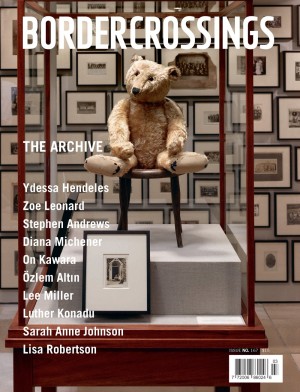Failing Successes
In 2005, when he was living in Vancouver, Derek Dunlop became obsessed with the Internet images of Lynndie England, an American soldier on duty at Abu Ghraib. The 22-year-old corporal could be seen smiling and pointing at naked prisoners who were being forced to perform humiliating acts. Hers was the Cheshire smile that stood in for all the abuse that occurred in that prison. It also became the subject of a number of works by the Winnipeg-based artist. “Her mouth took on greater connotations; it became this self-righteous smile; a smile in subservience to others (she was probably told what to do to and she was obviously scapegoated); even a smile of advanced capitalism, where everyone is smiling all the time and so everything is okay. It haunted me, and in my studio I kept looking for ways to resolve it by getting it out of my imagination.” Dunlop initially executed an empty smile on a huge sheet of white paper, moved through more drawings, and finally made a painting called England. That work resolved the subject to his satisfaction.
Dunlop is a diehard, studio-based artist. In that space, he exercises the various strategies of drawing through which he searches for a way to resolve his subject matter. His is a highly intellectual practice that produces elegantly visceral results. “When it comes to my work, I’m mostly influenced by critical theory,” Dunlop says. Both through reading and looking, he is aware of how other artists have approached drawing, including Andy Warhol, Agnes Martin, Cy Twombly, Jasper Johns, Sol LeWitt, Eva Hesse and Raymond Pettibon. Dunlop has taken many lines for a walk and, at his own admission, he has come up short. He recognizes that built-in to his project is the idea of failure. “Sometimes when I am halfway through a painting I realize it is going to be an ugly painting, and then I realize the subject matter is demanding it be ugly. Another painting may demand that it be beautiful to some degree, or some aesthetic concern comes from the subject. So there definitely is this struggle for or against an idea of beauty that constantly occurs in my work.”
One of his other areas of concern is the way pattern is written about in Sara Ahmed’s Queer Phenomenology (Duke University Press, 2006). Dunlop employs pattern and repetition and is engaged in a studio practice in which he poses questions and searches for material answers. Why do patterns emerge? How do we break them? And how do new patterns come out of old ones? These are all questions that his paintings and drawings ask, and when he finds the answers, however provisional they may be, the results are compelling. Side by Side is a fine painting that is one of Dunlop’s favourites. “I didn’t try to do anything with it. It just sort of happened. I always feel my paintings are most successful when my materials are talking to me more than I’m talking to my materials. I’m learning all the time, absolutely, but it won’t get in the way because I keep changing my technique or strategy. Side by Side works really well but I won’t consciously repeat it. As soon as I feel like I’m accomplishing some way of painting I sabotage myself and find a new way of making a painting. Because all the questions don’t go away: Is this a painting? What is a painting and how does a painting have meaning?”
Above images: (Left) Derek Dunlop, *smile, 2009, oil pastel, marker and pencil on canvas, 30 x 24”. (Centre) side by side, 2011, oil and pencil on canvas, 30 x 24”. (Right) untitled, 2011, carbon on paper, 26 x 20”.*

